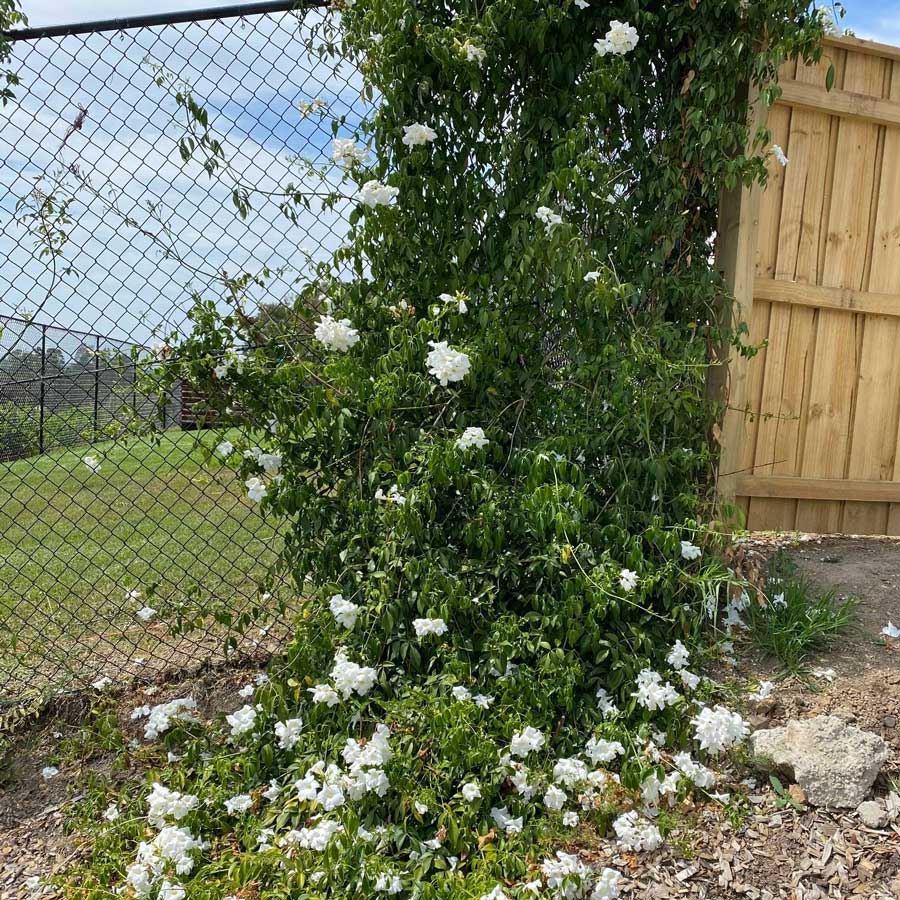Retaining walls, steep slopes and rockeries can be tricky spaces to fill for the average gardener. How do you add greenery in a space where the root zone is constricted?
Sure, it’s easy enough to find plants that will cascade down, but it gets tricky if you want to add some greenery above without accommodating for another separate climbing plant.
There are a few exotic plants that can do this very well, but our head breeder Todd and I believe we’ve found the best native plant option.

This native climber works just as well as a climber as it does as a ground cover. That, combined with the clean floral colour, is what earned this plant’s name.
Ozbreed Flat White™ Pandorea jasminoides ‘PJ01’ PBR
Characteristics and Growth
Ozbreed Flat White™ Pandorea has a dense and compact habit, which hugs surfaces more tightly than common forms while holding its leaves at the base much better than common forms.
It has the ability to climb up rockeries and trellises, while also covering horizontal or sloped ground and sending down cascading stems. It naturally wants to hug surfaces much better than other varieties, meaning it takes less effort to keep it compact.
When pruned, this climbing and trailing plant maintains a height of 2-3 metres and a width ranging from 40 to 60 centimetres. If left unpruned, it can spread to an impressive 80 centimetres to 2 metres wide, allowing it to cover larger areas.

These beautiful trumpet-shaped flowers are a magnet for native bees and butterflies.
Care and Maintenance
This versatile climber flourishes in full sun to part shade and adapts well to most soil types. It boasts moderate frost tolerance and good drought resistance, ensuring that it remains vibrant throughout various weather conditions.
Planting and Watering
To establish your Ozbreed Flat White™ Pandorea, water it as needed for the first 8 to 13 weeks. Planting in a well-mulched garden is recommended, with chunky mulch being the ideal choice. By doing so, you will provide the plant with the necessary nutrients and moisture retention.
While it’s drought tolerant, it will look better with irrigation.

This plant holds its foliage at the base much better than other varieties. Notice how it hugs both the ground and the fence, even though it hasn’t recently been pruned. Other varieties would either be defoliating or getting completely out of hand by this point.
Pruning and Fertilising
Pruning helps maintain the plant’s compact form. It’s suggested to prune a few months after planting and subsequently twice per year. While this variety is naturally compact, pruning once or more per year ensures a narrow and tight climber that fits perfectly in limited spaces.
You can prune the tips of stems, or you can remove larger stems back to a fork if you’d like to reduce the plants size while maintaining its natural shape. Just keep in mind that any prune you make above a root will kill everything above the cut, so remove the whole stem and compost it.
A slow-release fertiliser applied in spring will further support healthy growth. No need to worry about a “native” fertiliser – just use a regular compost, manure or other organic input which will feed the soil as well as your plants.
Source: https://anpsa.org.au/phosphorus-needs-of-some-australian-plants/
Purchasing and Availability
Due to its recent release, Ozbreed Flat White™ Pandorea may be somewhat challenging to find. Your best bet is to try our recommended online retailers, who will ship tubestock to your front door. https://www.ozbreed.com.au/where-to-buy/where-to-buy-ozbreed-plants-retail/
Conclusion
Ozbreed Flat White™ Pandorea is a remarkable climber that can climb up and cascade down slopes and rockeries. With its ability to thrive in tough conditions and its minimal maintenance requirements beyond pruning, it’s an excellent choice for gardeners looking to enhance their outdoor spaces with a hardy, attractive plant.
